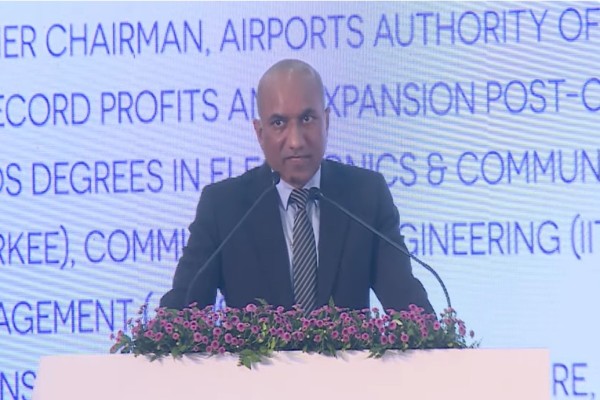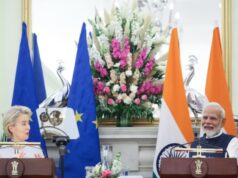
“Self-reliance would come when we have total control over our platforms and their components,” believes Sanjeev Kumar, Secretary, Defence Production, Ministry of Defence,
Delivering a keynote address on “Export as the Lever: India’s Next Big Push” at the 10th India Defence Conclave at the Constitution Club of India in New Delhi on November 4. Kumar traced India’s decade-long journey in defence manufacturing, calling it one of significant growth backed by bold policy initiatives and strategic clarity.
Over the past ten to twelve years, domestic defence manufacturing has grown 2.6 times — from about ₹46,000 crore per annum to over ₹1.5 lakh crore in the last financial year, he said. “That shows a very robust growth of more than 11–12 percent annually.”
Exports, he added, have grown even more sharply — from around ₹700 crore a decade ago to ₹23,240 crore last year. “Our target for defence exports by 2029–30 is ₹50,000 crore, while the target for domestic defence manufacturing is ₹3 lakh crore.”
Kumar pointed out that the ecosystem supporting this growth now includes over 16,000 micro and small enterprises. “Typically, defence manufacturing ecosystems are led by a few big platform players or integrators, supported by a large number of tier-one, tier-two and tier-three companies. That type of ecosystem is now developing in India,” he noted.
He credited a series of “very bold policy tools” crafted by the Government of India under the leadership of the Prime Minister and Defence Minister. Chief among them, he said, was the decision to reserve 75 per cent of the defence capital acquisition budget for procurement from Indian sources. Within this, priority is given to platforms that are “Indigenously Designed, Developed and Manufactured (IDDM).”
“The foremost objective of Make in India is self-reliance,” Kumar emphasised. “Self-reliance would come when we have total control over our platforms, software, vertical and horizontal integration, and supply chains—with no vulnerabilities, even to friendly countries, beyond a point.”
He warned against confusing indigenisation with simple domestic assembly of foreign technologies. “Technology coming from some other country and being manufactured here can at best be an intermediate goal. But many times, this intermediate goal clouds our vision and prevents us from moving firmly towards the ultimate goal,” he said. “IDDM — things indigenously designed and developed — should be our ultimate goal.”
The Defence Production Secretary underlined that demand creation had been crucial in attracting private investment into the sector. “This market is characterised by a single purchaser — the government — which is why demand must be created first,” he explained. Steps such as earmarking 75 percent of capital procurement for Indian firms and placing components on the Srijan portal had allowed small enterprises to enter the ecosystem successfully.
Licensing processes for defence manufacturing, he said, had been simplified considerably, with many items removed from the requirement altogether. “Although it still takes significant time to get a licence, we are rationalising the procedures and trying to create a better SOP in the future.”
Foreign direct investment norms have also been liberalised to encourage technology transfer. “Seventy-four per cent FDI is now permitted under the automatic route, and 100 per cent in cases involving advanced technologies where FDI is the only way of acquiring them,” he said. Schemes such as TDF and DCPP under DRDO, as well as iDEX and ADITI, were drawing young innovators and entrepreneurs into the defence ecosystem.
“These innovators are undertaking projects that allow them to dream and get integrated into the manufacturing value chain,” Kumar said, adding that testing facilities too were being streamlined to reduce development cycles. “An online testing portal was launched in March 2025, onboarding all labs owned by DRDO, DGQA, DPSUs, and the Services. We have also issued an SOP for the provision of proof stocks for private manufacturers.”
On exports, Kumar said the authorisation process had been simplified twice this year — in March and October 2025. “Eighty percent of applications are now cleared in less than ten days,” he said, adding that delays in the remaining cases usually involved consultations with embassies or the Ministry of External Affairs.
He disclosed that the Ministry was working on a system to recognise “trusted export houses” that could eventually be allowed a form of self-certification for certain categories of exports. “We are also exploring longer-term export authorisations for companies that have standing contracts or joint ventures with foreign OEMs,” he said.
Calling exports “a strategic necessity”, Kumar said domestic demand alone would not sustain the scale of manufacturing India aspired to. “To achieve economies of scale and diversification of products, part of our manufacturing must be geared for the global market,” he said. “Exports are vital for long-term sustenance of the domestic defence manufacturing base.”
He also spoke of the strategic importance of defence exports. “As many countries as we are friendly with—whether through diplomatic, military, or defence industrial ties—our manufacturing capabilities will always be useful when the game is played out at the regional or global level.”
Kumar noted that India had several natural advantages: a young pool of engineers, cost competitiveness, and experience working with both Western and Soviet-era technologies. “That gives us the flexibility to integrate with both technological blocs,” he said. “We can also service, upgrade, and integrate Soviet-origin equipment in countries across Africa, the Middle East, and Southeast Asia.”
At the same time, India’s exposure to Western technologies opened opportunities to partner with European countries that are expanding their defence industries. “The entire EU is in the process of rearming and increasing its defence spending from two to five percent in the coming decade. This offers potential for Indian companies to integrate into their supply chains or establish joint ventures,” he said.
Kumar concluded by urging the industry to look ahead to emerging domains. “The battlefield is changing, and technologies like AI, quantum computing, and autonomous systems are becoming pivotal. Instead of waiting for advanced countries to move first, we should put our energy, resources, and intelligence into these areas where we can leapfrog.”
In a career spanning three decades and counting, Ramananda (Ram to his friends) has been the foreign editor of The Telegraph, Outlook Magazine and the New Indian Express. He helped set up rediff.com’s editorial operations in San Jose and New York, helmed sify.com, and was the founder editor of India.com.
His work has featured in national and international publications like the Al Jazeera Centre for Studies, Global Times and Ashahi Shimbun. But his one constant over all these years, he says, has been the attempt to understand rising India’s place in the world.
He can rustle up a mean salad, his oil-less pepper chicken is to die for, and all it takes is some beer and rhythm and blues to rock his soul.
Talk to him about foreign and strategic affairs, media, South Asia, China, and of course India.
- Ramananda Senguptahttps://stratnewsglobal.com/author/ramananda-sengupta/
- Ramananda Senguptahttps://stratnewsglobal.com/author/ramananda-sengupta/
- Ramananda Senguptahttps://stratnewsglobal.com/author/ramananda-sengupta/
- Ramananda Senguptahttps://stratnewsglobal.com/author/ramananda-sengupta/




